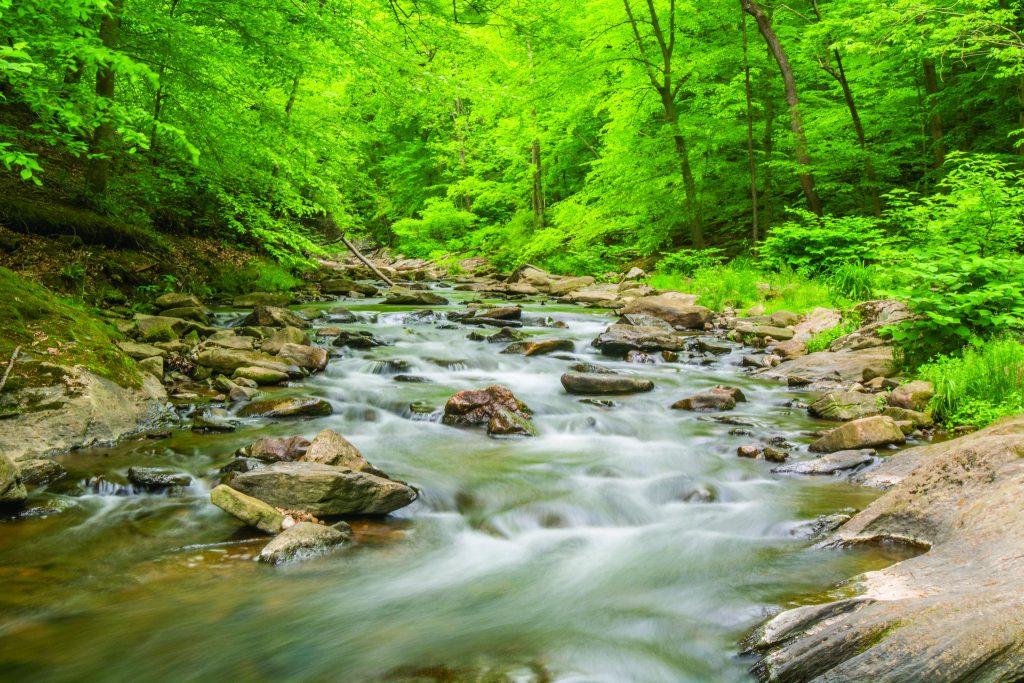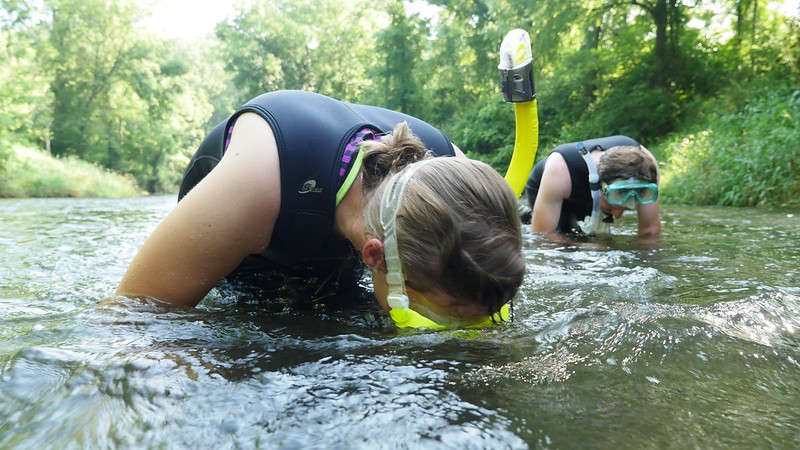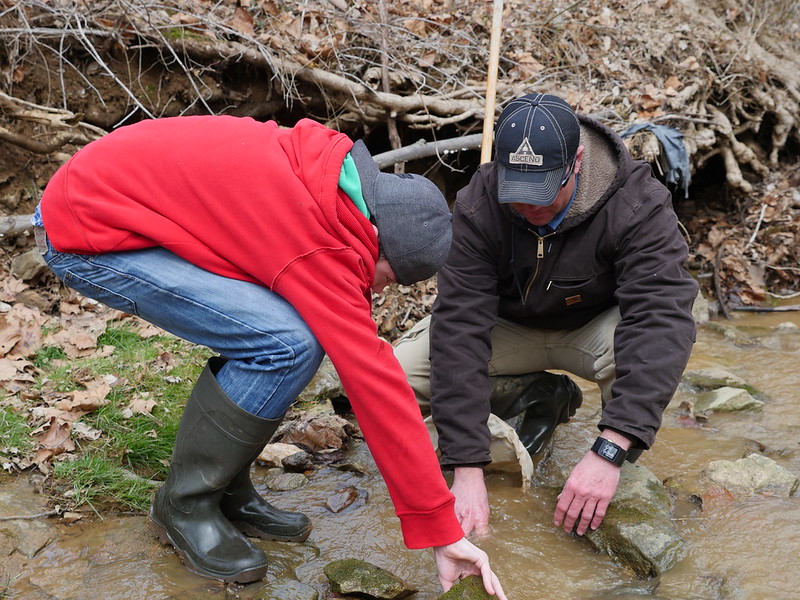Flow of Information: Surveying the Health of Maryland Streams
Maryland has more than 10,000 miles of freshwater streams—an extensive system of waterways flowing downstream where (depending on their geography) they ultimately contribute freshwater to the Chesapeake Bay, the Atlantic Coastal Bays, the Ohio River, or the Delaware River. The condition of these streams is vitally important to downstream waters. But these streams also possess significant inherent value.
The diversity of stream habitats throughout Maryland—from the cold mountain streams of Western Maryland to the slow, dark swamps of the Eastern Shore—support an amazing faunal diversity. This includes nearly 100 fish species, 16 native freshwater mussels, nine native cray-fishes, eight stream salamanders, and hundreds of different aquatic insects and other benthic macroinvertebrates.
Streams also support some particularly unique and sensitive species. Throughout the United States, freshwater animal groups such as freshwater mussels, crayfish, amphibians, and freshwater fishes have the highest proportion of imperiled species. For example, 69% of fresh-water mussels, 51% of crayfishes, and 37% of freshwater fishes are considered at risk nation-ally, based on information from a 2000 report written by the The Nature Conservancy and Association for Biodiversity Information, now known as NatureServe.
The Maryland Biological Stream Survey
The Maryland Department of Natural Resources’ Maryland Biological Stream Survey (MBSS) was initiated in 1995 to provide the in-formation necessary to evaluate the health of Maryland’s streams, to report on the diversity of life and habitats within them, and to inform stream ecological restoration and protection. The core of the MBSS consists of a statistical design that uses randomly selected stream locations throughout Maryland to provide a representative sample of overall stream health and biological diversity. In addition, a network of relatively intact “Sentinel Sites” provides a reference for comparing other streams and to track variability in stream conditions due to factors such as climate and weather. Sampling also takes place at specific locations to evaluate specific management actions.
At each site, the MBSS collects data about fish, aquatic insects and other macroinvertebrates, freshwater mussels, crayfish, amphibians, reptiles, and associated physical, chemical, and landscape variables. The MBSS uses benthic macroinvertebrate and fish indices of biological integrity, specifically developed for Maryland’s streams with standard scientific methods, to assess stream ecological condition (often referred to as stream health).
MBSS data are critical to meeting state and federal requirements for assessing the condition of Maryland’s waters. The Maryland Department of the Environment (the agency responsible for Maryland water quality regulations) uses these data to help designate waters as “impaired” (in need of water quality restoration) or “High Quality” (in need of water quality protection) and also to help deter-mine the factors that may be responsible for the conditions observed.
Biodiversity Conservation
The department’s Natural Heritage Pro-gram uses the biodiversity information from the MBSS in various conservation activities, including in collaborative efforts to determine the state conservation and legal status of freshwater animal species. Staff also work together to plan and evaluate conservation projects for select stream-dwelling animals. A recent example is a current focus on freshwater mussel restoration. Restoring these bivalves is not only important to stream biological diversity but also to stream water quality—freshwater mussels help clean stream water by filtering it while feeding.
Stream restoration and other practices are critically important to improving and protecting water quality and aquatic habitat in Maryland. More than 40 miles of projects were completed with Chesapeake and Atlantic Coastal Bays Trust Fund dollars in Maryland since 2010. MBSS staff collaborate with DNR Chesapeake and Coastal Service staff to help monitor some Trust Fund project sites—especially those that employ innovative restoration techniques—and provide data to evaluate their success.
Forest Buffers
Forested buffers help protect living re-sources and water quality, shading streams for cooler water and adding wood and leaves for diverse habitat, shelter, and food. MBSS data are used to bring stream health measures into targeting approaches by DNR’s Forest Service to help locate buffer restoration in areas with the greatest conservation need. MBSS sampling protocols also have been used to monitor and evaluate forest buffer planting projects in Maryland, linking our restoration efforts and stream health measures.
Coldwater Streams
The brook trout is Maryland’s only native trout and our most iconic coldwater stream species. Its presence is an indicator of stream health, it is important to Maryland’s biological diversity, and it provides unique fishing opportunities for freshwater anglers. Like brook trout, certain stonefly insects, in their aquatic larval stage, tend to live only in coldwater streams. MBSS data on these fish and insects and their habitats are used together with information from Fishing and Boating Services to assist in identifying, protecting, and restoring coldwater streams.
Removing Barriers
Through a partnership with American Rivers, the National Oceanic and Atmospheric Administration, and the U.S. Fish and Wildlife Service, the department has been collecting ecological data from the Patapsco River associated with the removal of dams. This project has potential benefits to resident and migratory fauna in the river. A particular emphasis for this project is on the potential benefits to migratory fishes such as river herring and eels. River herring are a spring-migrating group of fishes that live in the ocean and return to freshwater to spawn. For many years they were restricted from spawning areas upstream from Bloede Dam, which was removed in 2019. The American eel is a migratory fish that spawns in the Sargasso Sea in the Atlantic Ocean, but relies on rivers and streams to live for up to or more than 20 years. They are also a preferred host species for Maryland’s most common freshwater mussel, the eastern elliptio, a species largely absent from the Patapsco River. Larval eastern elliptio mussels attach to an American eel for a short time to complete their reproductive cycle. According to MBSS sampling results, the eels may also influence the densities of some fish and benthic macroinvertebrates. Although American eels were present upstream from Bloede Dam, even before the dam was removed, the removal is likely to facilitate increased abundance.
Fascinating Stream-Dwelling Fauna
The examples above highlight some of the important and varied uses of MBSS information and touch upon some of the abundant and amazing stream-dwelling biota for which the MBSS provides information. There are many other important and fascinating stream fauna in Maryland that contribute to our understanding of biodiversity and stream health. Although there is only room within this story to barely dip into stream fauna, a brief mention of a few others is warranted.
Large diversity, varied sensitivities to pollution, and specialized habits make aquatic insects like dragonflies, mayflies, stoneflies, dobsonflies, caddisflies, and others excellent indicators of stream health. Certain species of salamanders specialize in living in and along streams. As adults, these salamander species do not have gills or lungs, but instead breathe entirely through their skin. The most important factor influencing the nine native crayfish species found in Maryland is likely non-native crayfish. There are many streams in Maryland where only non-native species of crayfish can be found—they likely displaced the native species from their habitats.
Training and Certification
No matter what type of information is collected by MBSS surveys, scientific rigor and confidence in results is important. To ensure consistency, data comparability, and data quality, DNR staff and other stream monitoring professionals working on the MBSS undergo training. Opportunities to become certified in certain MBSS sampling methods are also offered. Those who attend training and pass the same written tests and field audits as DNR staff are provided with documentation indicating that their methods are consistent with those for the MBSS. Consistent sampling protocols used by professionals collecting data throughout Maryland’s streams allow for seamless comparability across projects and agencies for stream assessments—and also add data beyond those collected by DNR for assessing the health of Maryland’s waters.
Citizen Science
Maryland Stream Waders are volunteers trained by department staff to collect certain data from select Maryland streams. Through this opportunity, volunteers become informed about and engaged in benthic macroinvertebrate monitoring. Stream Waders data help DNR understand the families of benthic macroinvertebrates present in watersheds where certain DNR projects are occurring and give a preliminary screening of stream condition.
The Future Involves Looking Back
Measuring and documenting the conditions of Maryland’s streams through the projects and partnerships described here (and others) provides the basis to help inform stream management in Maryland. As this work continues, an essential question is whether stream ecological conditions are changing over time. MBSS recently re-sampled more than 400 stream sites that were initially sampled up to 20 years ago. The data from this five year sampling effort have been compiled and will be analyzed over the next couple of years.
Scott Stranko is the director of monitoring and nontidal assessment for the Maryland Department of Natural Resources. Appears in Vol. 23, No. 1 of the Maryland Natural Resource magazine, spring 2020.




 1-888-373-7888
1-888-373-7888 233733
233733